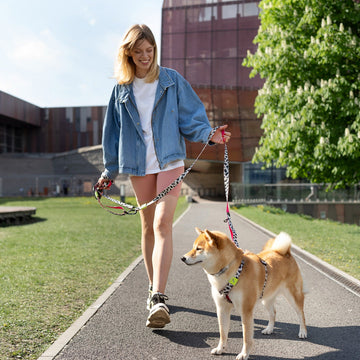As pet owners, one of the most important tools we can have in our arsenal is a high-quality pet leash. Whether you’re taking your dog for a walk, a run, or a trip to the park, a good leash ensures that your pet stays safe, secure, and under control. But with so many different types of leashes on the market, how do you choose the best one for your pet?
In this blog post, we’ll explore the different types of pet leashes available, the benefits they provide, and how to choose the right leash for your furry friend. From standard leads to retractable leashes, we'll help you navigate the world of pet leashes to find the perfect fit for your pet’s needs.
Why a Good Leash Matters
Leashes are essential for your pet's safety and comfort during outdoor adventures. Here are a few reasons why investing in a quality leash is important:
-
Control and Safety: A sturdy leash provides control over your pet, preventing them from running off into potentially dangerous situations, such as traffic or wild animals. It keeps your pet close and ensures their safety while exploring new environments.
-
Training: Leashes are a fundamental tool in training, whether you're teaching basic commands like “sit” and “stay” or working on more advanced skills. They help guide your pet’s behavior and keep them from pulling, lunging, or running away during walks.
-
Socialization: Using a leash helps your pet interact safely with other dogs, animals, and people. Leashes prevent unwanted contact and allow you to gradually expose your pet to new experiences in a controlled manner.
-
Comfort and Convenience: The right leash makes walks and outings more enjoyable for both you and your pet. Comfortable materials and ergonomic designs can make holding the leash easier and more pleasant for you while offering your pet a safe and secure connection.
Types of Pet Leashes
Choosing the right leash depends on your pet's size, behavior, and your specific needs. Let’s break down the most common types of pet leashes available:
1. Standard Leashes
Standard leashes are the most common and versatile type of leash. These leashes are simple, reliable, and come in a variety of materials, including nylon, leather, and cotton.
-
Nylon Leashes: Nylon is a strong and affordable material that is resistant to wear and tear. It is lightweight, durable, and easy to clean, making it a popular choice for everyday use.
-
Leather Leashes: Leather leashes are known for their durability and classic look. They are soft on the hands, long-lasting, and great for dogs that tend to pull. Over time, leather leashes develop a unique patina and become even more comfortable.
-
Cotton Leashes: Cotton leashes are soft and gentle, making them ideal for pets with sensitive skin or those prone to chafing. They are lightweight and available in a range of bright colors and patterns.
Best for: Daily walks, training, and general outings.
2. Retractable Leashes
Retractable leashes are designed to give your dog more freedom to explore while still allowing you to maintain control. These leashes are typically made of durable plastic and come with a spring-loaded mechanism that allows you to extend and retract the leash at will.
-
Pros: Retractable leashes give your dog more freedom while still keeping them attached to you. They are great for well-trained dogs that enjoy exploring but don’t need constant direction.
-
Cons: Retractable leashes are not ideal for training dogs that pull or for those who are not yet fully trained. The thin cord can also be a potential safety hazard, as it can snap back unexpectedly or cause injury.
Best for: Well-behaved dogs that are comfortable with some freedom and for areas where they can roam, like parks or trails.
3. Training Leashes
Training leashes are often longer and designed specifically for teaching leash manners, leash walking, or practicing recall commands.
-
Long Leashes: Long leashes (usually 10-30 feet) allow you to give your dog more freedom without losing control. They are ideal for recall training and teaching your pet to come when called while still staying connected.
-
Slip Leads: Slip leads are designed to train dogs that tend to pull or have difficulty walking on a leash. The adjustable loop tightens slightly when the dog pulls but doesn’t cause harm, offering an effective training tool.
Best for: Training, recall practice, and teaching leash manners.
4. Hands-Free Leashes
For pet owners who like to run or jog with their dogs, hands-free leashes are an excellent option. These leashes typically feature a waistband that you wear around your waist, allowing you to keep both hands free while maintaining control of your dog.
-
Benefits: Hands-free leashes are great for active pet owners who want to run or hike with their dogs without worrying about holding a leash. The leash is usually adjustable to accommodate different dog sizes and walking speeds.
-
Considerations: These leashes work best with well-behaved dogs that walk alongside you and are less prone to pulling.
Best for: Runners, joggers, and hikers who want to keep their hands free while walking their dogs.
5. No-Pull Leashes
No-pull leashes are designed specifically to help train dogs that pull excessively on their walks. They often feature a front-clip harness or a special attachment point that redirects your dog’s attention when they try to pull.
-
Front Clip Leashes: These leashes connect to a harness at the front, pulling the dog’s chest toward you when they pull, encouraging them to stop pulling and walk more calmly.
-
Head Halters: A head halter is a type of leash attachment that goes around your dog’s nose and head. It works by gently guiding their head, making it more difficult for them to pull.
Best for: Dogs that tend to pull on walks, particularly during training.
6. Chain Leashes
Chain leashes are made from metal links and are typically used for dogs that tend to chew through regular nylon or leather leashes. They are incredibly durable and difficult for strong chewers to destroy.
-
Pros: Strong, chew-resistant, and durable, making them perfect for dogs that are heavy chewers or escape artists.
-
Cons: Can be heavy and less comfortable to hold compared to nylon or leather leashes.
Best for: Dogs that are prone to chewing through their leashes or escape artists.
How to Choose the Right Leash for Your Pet
When selecting a leash for your pet, consider the following factors:
-
Your Pet’s Size: Larger dogs may require a thicker, stronger leash, while smaller dogs may do better with lighter, thinner leashes.
-
Your Dog’s Behavior: If your dog pulls or has leash-walking issues, a no-pull or training leash is ideal. If your dog enjoys exploring and you want them to have more freedom, a retractable leash or long leash could be the right choice.
-
The Activity: If you like running or hiking with your dog, a hands-free leash is a great option. For everyday walks, a standard leash or a retractable leash may be more suitable.
-
Comfort: Make sure the leash is comfortable for you to hold and easy for your dog to wear. Leashes with padded handles are great for reducing hand strain, especially if your dog pulls.
Conclusion
A good leash is a must-have tool for any pet owner. It provides control, safety, and convenience during outdoor activities, whether you’re walking, training, or running with your dog. With so many different types of leashes available, it’s essential to choose the one that best suits your dog’s size, behavior, and your lifestyle.
By selecting the right leash, you’ll ensure that your walks and outings are enjoyable for both you and your furry friend. So, whether you need a retractable leash, a training leash, or a hands-free option, there’s a perfect leash out there to meet your needs and keep your pet safe while exploring the world with you. Happy walking!




